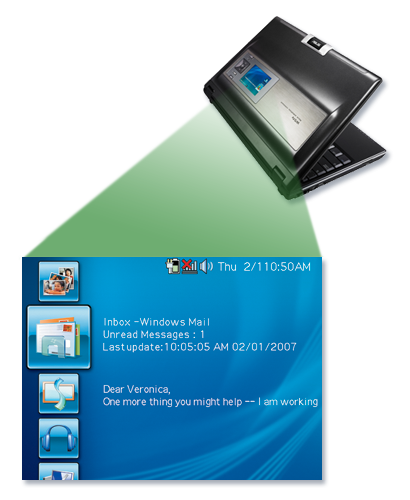I have been interested in the .NET Micro Framework since 2007. At the end of 2009, I bought my first board with a chip from GHI, on which the .NET Micro Framework is able to run. I was looking forward to writing an article comparing the development environment and software deployment to Atmel ATmega16 and GHI Embedded Master. However, I never dreamed that my first article on this topic would be about something completely different.
You may still remember how Bill Gates showed the new possibilities of Windows Vista. One of them was Windows SideShow technology demonstrated on an Asus laptop. It was a standalone computer based on an ARM processor, which was used to read emails from a small display without having to turn on the entire laptop. It was based on Microsoft SPOT (Smart Personal Object Technology), which has its roots in FM radio, which was able to display information from MSN services. Other applications were watches. Unfortunately, they didn't sell much, because most people don't like the feeling that their watch runs .NET.

The .NET Micro Framework has its great charm. For someone who has experience with programming microcontrollers in C or assembly language, the ability to touch the processor pin in C# is simply an amazing feeling. I consider writing programs that run from microcontrollers to mobile phones, PCs to servers and data centers from one modern development environment using the same high-level language to be Microsoft’s greatest achievement in this century.

Green Embedded Master with pins to a more accessible 2.54mm pitch and with built-in Ethernet and USB interfaces.
After buying the hardware, the aforementioned GHI Embedded Master Breakout Board equipped with a non-TFT version, I had to hand it in and it was returned to me on December 24. Soon after that, I started working on my first programs, back then still in Visual Studio 2008. The board was heating up more than I expected, but having a Noctua NH-U12P cooler on my Core i7 didn't seem strange to me.

The Noctua NH-U12P cooler for Intel Core i7 may in certain cases give a false idea of the heat dissipation of some chips.
The development went on, so I eventually installed Visual Studio 2010. However, applications could not be deployed to the Embedded Master after that. Attempts to deploy from another PC from Visual Studio 2008 were successful at first, but then it turned out that switching to a newer version of the development environment is not the cause of the problem. Over time, the Embedded Master was not even recognized by the operating system as a USB device. Flashing the new firmware helped. Embedded Master was visible again and I was happy to be developing again. But that was a mistake. Because only the GHI firmware was flashed without updating the TinyBooter, the device kept plugging in and out as the TinyBooter kept rebooting trying to boot TinyCLR 4.1 from its version 3. So I studied the necessary manuals and started making a converter from RS232 to TTL UART using the MAX232 chip.
The recording was done by sitting at the PC in the role of Tera Term’s operator and my brother was the board reset operator. While I was trying to ping COM and saying “Still nothing, still nothing,” my brother suddenly called out, “Unplug, unplug!” I hurriedly unplugged the USB power cable and leaned over to the board to talk about what had happened. One chip on the Embedded Master was so hot that it melted the antistatic plastic casing on which it was lying. There was a clear bulge on the surface of the chip, and by smelling it, one could guess his certain death.
“You were lucky you didn't blow up your motherboard,” my brother said, because I didn't have an older PC at hand to which I could safely connect a circuit assembled on a bastl field. I didn't understand what the mistake was. We both checked the scheme independently at least four times. I followed the recommended MAX232 connection given by the manufacturer. Immediately after connecting the power supply, I checked with the meter if there was an overvoltage in any branch. Only then did I realize it. When I was looking at the Embedded Master shortly after purchase, I found out by touch that there was a small bulge on the chip. When I tilted the case appropriately against the light, it was also visible. However, I considered it a defect of the case. And that was a mistake, now an experience.

After the last warm-up, the bulging chip cover is clearly visible.
A complaint was out of the question, both because of the long time gap and because I should have recognized the defect immediately when handing over the goods. Neither the manufacturer nor the seller is the cause of the problem. It’s a school that didn't equip me with practical knowledge.
One learns from mistakes, so there is nothing left but to try to get the defective 48LCHM16A2 chip and replace it. The first step is to cut off the chip with a scalpel and see if the printed circuit board underneath has suffered damage.

The scalpel has proven to be the most useful accessory for the microscope.
I can't determine if the other parts are okay with my knowledge and equipment. Given the price difference between the EMX Board, as the Embedded Master is now called, and the faulty chip, it’s worth a try.

